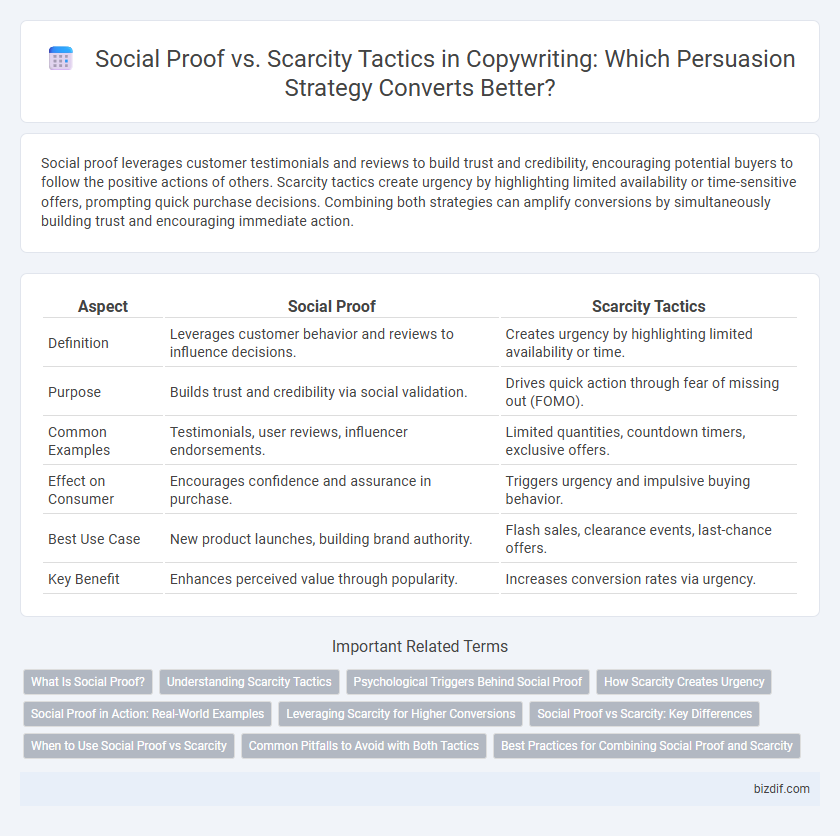Social proof leverages customer testimonials and reviews to build trust and credibility, encouraging potential buyers to follow the positive actions of others. Scarcity tactics create urgency by highlighting limited availability or time-sensitive offers, prompting quick purchase decisions. Combining both strategies can amplify conversions by simultaneously building trust and encouraging immediate action.
Table of Comparison
| Aspect | Social Proof | Scarcity Tactics |
|---|---|---|
| Definition | Leverages customer behavior and reviews to influence decisions. | Creates urgency by highlighting limited availability or time. |
| Purpose | Builds trust and credibility via social validation. | Drives quick action through fear of missing out (FOMO). |
| Common Examples | Testimonials, user reviews, influencer endorsements. | Limited quantities, countdown timers, exclusive offers. |
| Effect on Consumer | Encourages confidence and assurance in purchase. | Triggers urgency and impulsive buying behavior. |
| Best Use Case | New product launches, building brand authority. | Flash sales, clearance events, last-chance offers. |
| Key Benefit | Enhances perceived value through popularity. | Increases conversion rates via urgency. |
What Is Social Proof?
Social proof is a powerful copywriting tactic that leverages the influence of other people's actions and opinions to build trust and credibility for a product or service. Common examples include customer reviews, testimonials, case studies, and user-generated content that demonstrate widespread approval and satisfaction. This technique increases conversion rates by reassuring potential buyers that others have had positive experiences, reducing hesitation and boosting confidence in the purchase decision.
Understanding Scarcity Tactics
Scarcity tactics leverage the psychological principle of limited availability to drive immediate consumer action by creating a sense of urgency. These techniques often include countdown timers, limited stock notifications, or exclusive offers to increase perceived value. Effectively implemented scarcity tactics can significantly boost conversion rates by motivating hesitant buyers to make faster decisions.
Psychological Triggers Behind Social Proof
Social proof leverages the psychological trigger of social validation, where individuals look to others' behavior to guide their own decisions, reducing uncertainty and enhancing credibility. This tactic taps into the human need for belonging and trust, making potential customers more likely to follow popular choices or endorsements. Scarcity tactics, in contrast, rely on the fear of missing out (FOMO), but social proof fosters a deeper sense of confidence by highlighting widespread acceptance and approval.
How Scarcity Creates Urgency
Scarcity tactics trigger urgency by limiting availability, prompting immediate action to avoid missing out. Creating a sense of rarity intensifies desire, pushing consumers to convert faster. Psychological studies show that scarcity increases perceived value, driving higher engagement and sales.
Social Proof in Action: Real-World Examples
Social proof in copywriting leverages customer testimonials, reviews, and influencer endorsements to build trust and credibility, significantly boosting conversion rates. Brands like Amazon prominently display star ratings and user feedback, creating a powerful sense of validation that encourages purchases. This tactic proves effective by tapping into consumers' natural tendency to follow the actions of others, reinforcing positive buying decisions.
Leveraging Scarcity for Higher Conversions
Leveraging scarcity tactics in copywriting creates urgency by emphasizing limited availability or time-sensitive offers, driving immediate action and higher conversion rates. Using phrases like "only a few left" or "exclusive deal ends soon" taps into the fear of missing out (FOMO), compelling customers to purchase quickly. When combined with clear, tangible benefits, scarcity effectively motivates buyers to convert faster than relying solely on social proof.
Social Proof vs Scarcity: Key Differences
Social proof leverages testimonials, reviews, and user-generated content to build trust and validate a product's value, while scarcity tactics create urgency by highlighting limited availability or time-sensitive offers. Social proof appeals to the audience's desire for community validation, increasing credibility and reducing purchase anxiety. Scarcity drives immediate action through fear of missing out (FOMO), but trust-building remains a distinct advantage of social proof in long-term customer relationships.
When to Use Social Proof vs Scarcity
Social proof is most effective when building trust and credibility, especially for new products or services seeking to establish authority through customer testimonials, reviews, or case studies. Scarcity tactics work best for time-sensitive offers or limited-quantity deals to create urgency and prompt immediate action from potential buyers. Choosing between social proof and scarcity depends on the marketing goal: long-term relationship building or short-term conversion boosts.
Common Pitfalls to Avoid with Both Tactics
Overusing social proof can lead to diminished trust as consumers may perceive reviews or testimonials as fake or manipulated. Scarcity tactics often backfire when customers detect false urgency or limited availability, resulting in skepticism and frustration. To maintain credibility, marketers should ensure authenticity in social proof and use scarcity genuinely without exaggeration.
Best Practices for Combining Social Proof and Scarcity
Combining social proof and scarcity tactics enhances conversion rates by leveraging trust and urgency simultaneously. Highlight authentic customer testimonials alongside limited-time offers or low stock indicators to build credibility while prompting immediate action. Use clear, concise messaging and real-time data to maintain transparency and avoid skepticism.
Social Proof vs Scarcity Tactics Infographic

 bizdif.com
bizdif.com